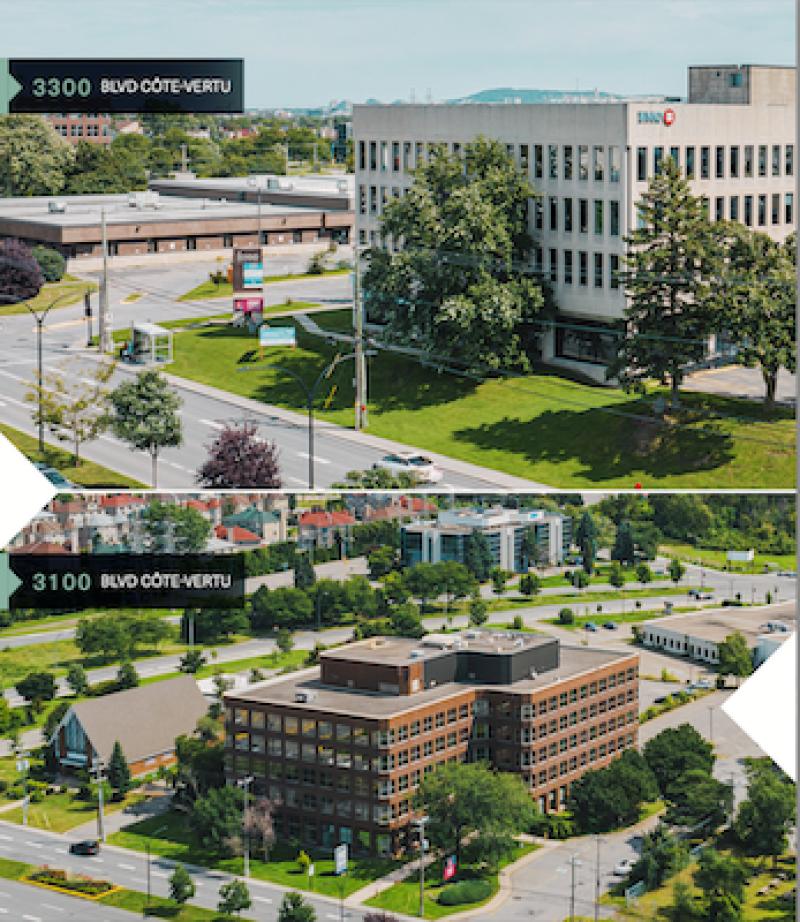
A 193,565-square-foot suburban office portfolio in Montreal’s Saint-Laurent district is for sale at a time when private capital is dominating the transaction market with long-term investors seeking well-priced assets.
The Côte-Vertu portfolio consists of four- and five-storey properties adjacent to the Place Vertu shopping centre. It is being sold by Cominar and marketed by CBRE.
“The Côte-Vertu portfolio provides an exceptional value-creation opportunity for the incoming investor,” CBRE vice-chairman Scott Speirs wrote to RENX in an email exchange. “The buildings are located in the heart of St-Laurent in an area poised for significant residential densification.
“Quality office buildings in prime locations can be acquired at a fraction of replacement costs. The key to successfully investing in value-add office at the moment is to have a business plan that accounts for several years of downtime before a return to stabilization and growth.”
3100 and 3300 Côte-Vertu properties
3100 Côte-Vertu is a five-storey building constructed in 1984 containing 94,804 square feet of gross leasable area. It sits on an 82,432-square-foot property.
3300 Côte-Vertu is a four-storey building constructed in 1991 offering 98,761 square feet of leasable space on a 127,446-square-foot lot.
Both properties have surface parking and they are 68 per cent occupied with a weighted average remaining lease term of three years. Key tenants include the Bank of Montréal, Stella-Jones, Aerotek, Synnex and the Government of Québec.
Place Vertu is the largest shopping centre in Saint-Laurent, with approximately 130 stores and services.
The area is also slated for residential intensification and offers access to Highway 40, which is located just behind the properties.
While Montreal’s citywide office vacancy increased 60 basis points to 17.4 per cent, according to CBRE’s Q2 2023 report, Speirs said there is reason for optimism in the market.
“Return to office has been relatively slow and historically speaking, Montreal has been a market with limited rental growth at the best of times.
"The one silver lining, however, is that relative to Toronto and Vancouver, there has been limited supply of new inventory in recent years,” Speirs wrote, noting suburban office is also slated to get a lift from impending expansions to the city’s transit system.
“In regards to the suburbs, Montreal presents a unique opportunity for growth that will be (underpinned) by its world-class transit. The imminent arrival of the new light rail (REM) will be a game-changer for public transit in Montreal.
“In addition, construction has just started on the extension of the subway to the east end of the Island. Montreal will soon be able to stake the claim to having some of the best public transit in the world and the ease of movement of its workers will drive demand across the suburbs.”
Private investors dominate office investment
He noted that virtually all buyers in the market at this time are private investors seeking high-quality properties in “irreplaceable prime locations.”
Jesta Group recently acquired a Westmount retail/commercial/office facility and Groupe Mach has also been an active buyer in Quebec and across the country. Mach’s strategy has been to acquire properties where the land value acts as a backstop to the asset located on the site.
“Private capital is driving the office investment market at the moment. The Canadian institutions continue to almost entirely shun the asset class. Even the savvy institutions, who recognize the cyclical opportunity, cannot rally their investor base to place money in the asset class,” Speirs explained.
“Therefore, private capital, with limited competition, dominates the office investment market by taking a contrarian view in their pursuit of outsized risk-adjusted returns.”










